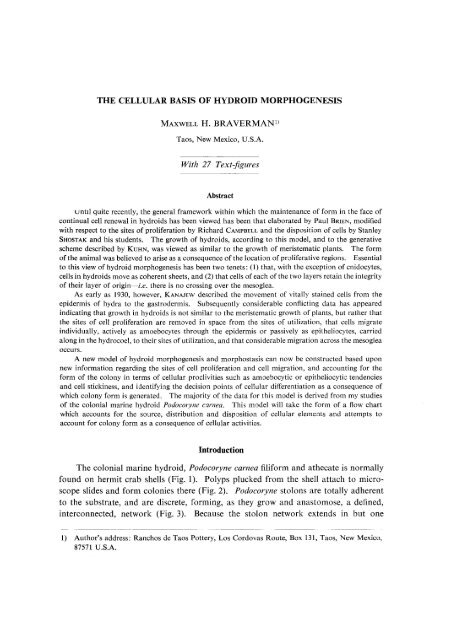THE CELLULAR BASIS OF HYDROID MORPHOGENESIS
THE CELLULAR BASIS OF HYDROID MORPHOGENESIS
THE CELLULAR BASIS OF HYDROID MORPHOGENESIS
You also want an ePaper? Increase the reach of your titles
YUMPU automatically turns print PDFs into web optimized ePapers that Google loves.
<strong>THE</strong> <strong>CELLULAR</strong> <strong>BASIS</strong> <strong>OF</strong> <strong>HYDROID</strong> <strong>MORPHOGENESIS</strong><br />
MAXWELL H. BRA VERMAND<br />
Taos, New Mexico, U.S.A.<br />
With 27 Text-figures<br />
Abstract<br />
until quite recently, the general framework within which the maintenance of form in the face of<br />
continual cell renewal in hydroids has been viewed has been that elaborated by Paul BRIEN, modified<br />
with respect to the sites of proliferation by Richard CAMPBELL and the disposition of cells by Stanley<br />
SHOSTAK and his students. The growth of hydroids, according to this model, and to the generative<br />
scheme described by KuHN, was viewed as similar to the growth of meristematic plants. The form<br />
of the animal was believed to arise as a consequence of the location of pwliferative regions. Essential<br />
to this view of hydroid morphogenesis has been two tenets: (I) that, with the exception of cnidocytes,<br />
cells in hydroids move as coherent sheets, and (2) that cells of each of the two layers retain the integrity<br />
of their layer of origin-i.e. there is no crossing over the mesoglea.<br />
As early as 1930, however, KANAJEW described the movement of vitally stained cells from the<br />
epidermis of hydra to the gastrodermis. Subsequently considerable conflicting data has appeared<br />
indicating that growth in hydroids is not similar to the meristematic growth of plants, but rather that<br />
the sites of cell proliferation are removed in space from the sites of utilization, that cells migrate<br />
individually, actively as amoebocytes through the epidermis or passively as epitheliocytes, carried<br />
along in the hydrocoel, to their sites of utilization, and that considerable migration across the mesoglea<br />
occurs.<br />
A new model of hydroid morphogenesis and morphostasis can now be constructed based upon<br />
new information regarding the sites of cell proliferation and cell migration, and accounting for the<br />
form of the colony in terms of cellular proclivities such as amoebocytic or epitheliocytic tendencies<br />
and cell stickiness, and identifying the decision points of cellular differentiation as a consequence of<br />
which colony form is generated. The majority of the data for this model is derived from my studies<br />
of the colonial marine hydroid Podocoryne carnea. This model will take the form of a flow chart<br />
which accounts for the source, distribution and disp:)sition of cellular elements and attempts to<br />
account for colony form as a consequence of cellular activities.<br />
Introduction<br />
The colonial marine hydroid, Podocoryne carnea filiform and athecate is normally<br />
found on hermit crab shells (Fig. 1 ). Polyps plucked from the shell attach to microscope<br />
slides and form colonies there (Fig. 2). Podocoryne stolons are totally adherent<br />
to the substrate, and are discrete, forming, as they grow and anastomose, a defined,<br />
interconnected, network (Fig. 3). Because the stolon network extends in but one<br />
1) Author's address: Ranchos de Taos Pottery, Los Cordovas Route, Box 131, Taos, New Mexico,<br />
87571 U.S.A.

















